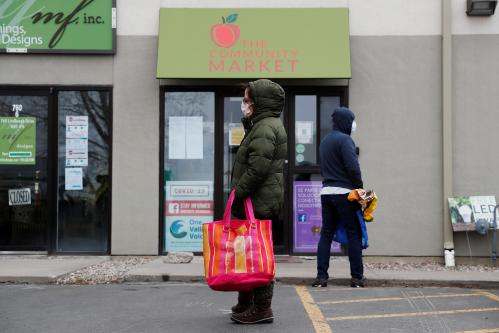On March 11, President Joe Biden signed the $1.9 trillion American Rescue Plan into law. But an earlier, House-passed provision to increase the federal minimum wage to $15 per hour was not included.
According to the Congressional Budget Office, the $15 federal minimum wage would have boosted the earnings of low-wage workers and decreased poverty. In its absence, a national policy agenda focused on raising wages is still urgently needed.
For now, at least, increasing the minimum wage will remain a bottom-up exercise led by local and state policymakers. In a new report, we argue that raising the wage floor can not only help reduce poverty (a worthy goal unto itself), but it can also support individual and family self-sufficiency—the ability to cover living expenses without relying on public subsidies.
To understand the landscape of struggling individuals and households, our report asked a simple question: Do individuals and families earn enough to make ends meet in the communities where they live?
We found that for a large share of the U.S. population, wages leave them short of self-sufficiency. As of 2019 (the latest data available), 37% of U.S. households—38 million overall—did not earn a pre-tax, pre-transfer wage that allowed them to make ends meet, including 14 million households with children. Owing to historical racial injustices and structural inequities, 47% of Black households and 50% of Latino or Hispanic households struggle to make ends meet.
A local perspective here is critical, because the share of households that struggle to make ends meet varies considerably across the United States due to diverging labor market conditions and costs of living. Over 40% of households were struggling to make ends meet in places such as Miami, Las Vegas, Orlando, Fla., and Los Angeles. In contrast, the struggling share of households was closer to 25% for Pittsburgh, Boston, and Seattle.
To understand more precisely how the minimum wage or other policies might alleviate these challenges, we estimate a “family-sustaining wage” threshold for each metro area that would help lift half of its struggling households into self-sufficiency. Looking at all households, including those without children, family-sustaining wage thresholds range from $12 in Brownsville, Texas to $23 in San Jose, Calif. (Table 1). Among 53 metro areas with at least 1 million residents, the typical family-sustaining wage threshold is around $14.70 per hour—close to the value for regions such as Nashville, Tenn. and Birmingham, Ala.

While wages and living expenses differ, every metro area has more struggling individuals and families than jobs that pay family-sustaining wages. Our data interactive lists these figures for 192 U.S. metro areas, and suggests that higher wage floors will not only reduce poverty and improve earnings for low-wage workers, but they also can make a meaningful difference in economic self-sufficiency—especially for households without children.
Indeed, a key finding of our analysis is that the impact of a higher minimum wage on family self-sufficiency depends greatly on family composition. Consider a thought experiment in which the entire nation adopts a $15 minimum wage. Single-adult households account for 19 million of the nation’s struggling households—about half of such households—yet they represent more than three-quarters of households that could reach self-sufficiency with a $15 wage (Chart 1). On the other hand, 14 million—or 40%—of all struggling households are families with children, but they account for only 14% of households that would reach self-sufficiency with a $15 wage.

The geographic variation is even more striking. Because the cost of living is substantially lower in smaller communities, households in small metro areas, micropolitan areas, and rural areas are more likely to reach self-sufficiency with a $15 federal minimum wage (Chart 2). Among the struggling households that would make ends meet with a $15 minimum wage, only 45% are in very large metro areas with populations exceeding 1 million—smaller than the 57% of struggling households they account for.

Significant variations exist even within those large and very large metro areas. In the nation’s most expensive places—San Jose, Calif., San Francisco, Honolulu, Washington, D.C., and New York—fewer than 10% of struggling households would achieve self-sufficiency with a $15 hourly wage (Table 2). Many of these cities and their states have already enacted policies to increase their minimum wages. In comparison, more than two-thirds of struggling households in Madison, Wis., Lansing, Mich., and Pittsburgh would achieve self-sufficiency with a $15 hourly wage. Many of these metro areas contain large universities, and likely reflect the significant number of student households living (temporarily) on low wages.

One strand of the debate about raising the federal minimum wage has registered concerns about disparate regional impacts—particularly, that a $15 minimum wage would prove too costly for businesses in low-cost regional economies. But viewed from the perspective of workers and families, it is in those same smaller, more affordable cities where a higher minimum wage could lift the largest shares of struggling families into self-sufficiency. Notably, in many metro areas (including some large metro areas), a wage threshold set between $12 and $13 per hour would lift half of struggling households—a majority of whom are childless households—into self-sufficiency.
In the end, economic self-sufficiency—whether households can make ends meet through their wage income alone—is just one metric for assessing the efficacy of policies like a minimum wage increase. But for the tens of millions of Americans struggling to afford the costs of living in their local communities, it’s arguably the metric that matters most.
The Brookings Institution is committed to quality, independence, and impact.
We are supported by a diverse array of funders. In line with our values and policies, each Brookings publication represents the sole views of its author(s).








Commentary
A $15 minimum wage would help millions of struggling households in small and mid-sized cities achieve self-sufficiency
March 17, 2021